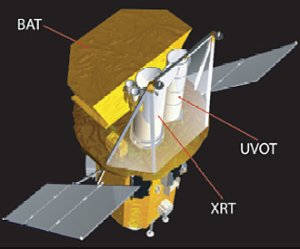

In a previous article, we discussed the first two major telescopes that were used to study gamma ray bursts (GMBs). These two were the Vela satellites and the Compton Gamma Ray Observatory (CGRO). There was a significant gap between the creation of Vela and the creation of its successor — CRGO. Ultimately, over two decades passed, but despite the time frame between these two observatories, both were an integral part of the future of space telescopes and paved the way for future missions, like BeppoSAX .
Tsvi Piran, an astrophysicist who has been at the forefront of gamma-ray burst physics for several decades, describes CGRO as being the “First Revolution” and BeppoSAX as the “Second Revolution.”
In 1996, a new satellite was launched by the Italian Space Agency and the Netherlands Institute for Space Research. BeppoSAX was named after the Italian physicist Guiseppe “Beppo” Occhialini. SAX, when translated into English, is “Satellite for X-ray Astronomy”. This satellite had a very broad range of detection. 2-26 keV is covered by the Wide Field Cameras [WFC], but other instruments are capable of detecting up to 700 keV.
As the name suggests (the SAX part, anyways), BeppoSAX’s main objective was assisting with X-ray astronomy, but it still helped us take a giant leap forward in our understanding of GRBs and their place in the universe. BeppoSAX had the Gamma-Ray Burst Monitor [GRBM], which was sensitive over the ranges of 40-700 keV. GRBM consisted of four anticoincidence shields positioned around the BeppoSAX satellite. Each shield was made from CsI(NA), and was 10mm thick and had a surface area of 1136 cm^2. It was able to detect almost the entire sky (apart from where some equipment got in the way).
The major breakthrough that BeppoSAX brought us was the knowledge that GRBs have an X-ray afterglow; this was discovered in 1997 (so only about a year after it began operating). After the burst was initially detected, the X-ray afterglow was detected by the observatory in GRB970228 (the name given to this particular burst) for up to a month. Another major find was the discovery that the afterglow was detectable in other ranges besides optical. It was through this afterglow discovery that astronomers started looking at the X-ray and radio emissions of a GRB. From this, the researchers were able to determine the redshift of these bright events. Through both X-ray and optical observations, GRB970508 was determined to have a redshift of z= 0.835 due to the Fe II and Mg II emission lines. This was the first direct evidence that confirmed that GRBs were not located in the Milky Way (however, this was just a confirmation of what was already assumed from the data collected by BATSE).
BeppoSAX remained in orbit collecting data for 6 years, from April 1996 until April 2002 when it was destroyed through a controlled re-entry. Over those years the satellite detected 1082 GRBs, and although the previous observatory (CGRO) detected approximately twice as many events, BeppoSAX possible gave more to the field of GRB astronomy with its discoveries. BeppoSAX also had in its catalogs 33 x-ray afterglows out of 39 detections.

Swift was launched in 2004 and is still in operation over 9 years later, so it has had a longer life than the previous gamma-ray observatories. Swift is an observatory that was built and sent into orbit for the specific purpose of studying GRBs. Swift has three instruments to study GRBs in multiple parts of the electromagnetic spectrum. The purpose of these three instruments is not only to detect the GRBs, but to get a multi-wavelength view of the afterglow. Swift not only studies the GRBs but also sends out the location of a GRB to observatories all around the world — and it does so within 20 seconds of a detection, allowing for multiple ground based sites to image the GRB. After a detection, Swift can slew to a GRB detection in less than 90 seconds to start imaging the x-ray and optical afterglow.
The three pieces of equipment are:
1.) Burst Alert Telescope [BAT] – This instrument detects upwards of 100 bursts a year and is more sensitive than all previous GRB detectors. It has a detection range of 15-150 keV with an energy resolution of ~7 keV and is capable of viewing about one sixth of the entire sky at any given time.
2.) X-Ray Telescope [XRT] – This instrument has a detection range of 0.2-10 keV and a resolution of 2.36 arcseconds/pixel on a 600×600 pixel detector. The XRT is used in preset observations when it isn’t being used to view GRB afterglows; this means it does spend more time observing objects other than GRB afterglows.
3.) Ultraviolet/Optical Telescope [UVOT] – This instrument is virtually the same as the Optical Monitor that was used in XMM-Newton and has a detection band pass between 170-650 nm. UVOT has two main functions, to view the UV and Optical component of the afterglow of GRBs but it is also used to determine redshift by looking for the Lyman Alpha cut off. UVOT is capable of getting down to magnitude 24 with a single 1000s observation.
There are and have been many more telescopes for both x-rays and gamma-rays; however, the four mentioned in Part I and Part II have been the main steps forward in our understanding of GRBs over the last few decades.
-Vela accidentally detected the first GRBs.
-The Compton Gamma-Ray Observatory told us that GRBs are isotropic throughout the sky.
-BeppoSAX gave us insight into their actual distance [that they aren’t apart of the Milkyway] by detecting the redshift for the first time.
-And Swift, the first GRB detector fast enough to send out accurate positions on new detections moments after they happen.